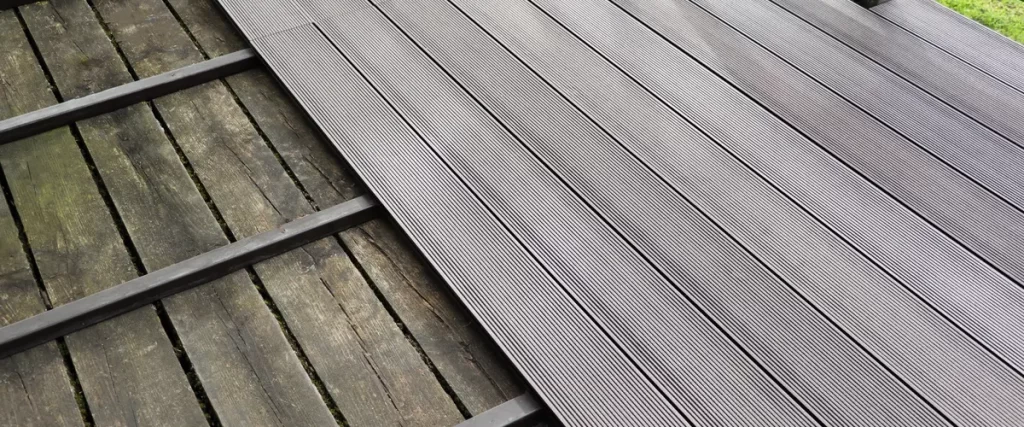If you’re thinking about deck building services for your home or deck replacement an old one, you’ve probably come across two main options: composite decking and wood. Both have their pros and cons, and the choice really depends on your needs, budget, and style. But don’t worry—this post will break everything down in super simple terms so you can make the best decision for your home.
Let’s dive into what makes composite decking and wood different and see which one might work better for your outdoor space!

What Is Composite Decking?
Composite decking is a type of material made from a mix of wood fibers and plastic. It’s designed to look like wood but with some modern twists that make it low-maintenance and super durable.
Key Features of Composite Decking:
- Comes in a variety of colors and finishes to mimic real wood.
- Resistant to rot, insects, and fading.
- Doesn’t splinter or warp over time.
- Easy to clean—just hose it down or wipe it with soapy water.
What Is Wood Decking?
Wood decking is made from natural wood, and it’s been a go-to option for decks for decades. It’s classic, warm, and has that natural charm that many people love.
Key Features of Wood Decking:
- Available in different types like cedar, redwood, and pressure-treated lumber.
- Can be stained or painted in various colors.
- Naturally beautiful and timeless.
- Requires regular maintenance like sealing and deck staining.
Appearance: Which Looks Better?
Wood Decking: If you love the look and feel of real wood, you can’t beat the natural beauty of wood decking. It has unique grains and textures that give it character. Over time, it can weather to a rustic look, which some people love.
Composite Decking: Composite decking has come a long way in mimicking the look of wood. While it doesn’t have the same natural imperfections as wood, it offers a more consistent, polished appearance. Plus, it doesn’t fade or change color as wood does.
Verdict:
- Choose wood if you want that authentic, natural look.
- Go with composite if you prefer a clean, uniform style.
Durability: Which Lasts Longer?
Wood Decking: Wood is strong and sturdy, but it’s more vulnerable to the elements. Over time, it can rot, warp, or get damaged by insects. Even with regular maintenance, wood decking may only last about 10–15 years.
Composite Decking: Composite decking is built to last. It’s resistant to rot, mold, and insects, and it doesn’t crack or splinter like wood. Most composite decks can last 25–30 years or more with little upkeep.
Verdict: If you want a deck that will stand the test of time, composite decking is the clear winner.
Maintenance: Which Is Easier to Care For?
Wood Decking: Wood requires a bit of TLC. You’ll need to sand, seal, or stain it regularly to keep it looking good and protect it from the elements. Cleaning a wood deck involves more effort, especially if you’re dealing with mold, mildew, or stains.
Composite Decking: Composite decking is all about convenience. No sealing, no staining—just occasional cleaning with soap and water. It’s perfect if you want a low-maintenance deck.
Verdict: If you’re not a fan of ongoing upkeep, composite decking is your best bet.
Cost: Which Is More Affordable?
Wood Decking: Wood is usually cheaper upfront. Pressure-treated wood is one of the most affordable options, while cedar and redwood cost a bit more. However, keep in mind that the maintenance costs can add up over the years.
Composite Decking: Composite decking has a higher upfront cost, but it saves you money in the long run since you won’t need to buy stains, sealants, or deck repair.
Verdict:
- If you’re on a tight budget, wood might make sense initially.
- If you think long-term, composite could save you money over time.
Environmental Impact: Which Is Greener?
Wood Decking: Wood is a natural and renewable resource, but harvesting trees can have an environmental impact. You can choose sustainably sourced wood to reduce this impact.
Composite Decking: Composite decking is made from recycled materials like plastic and wood scraps, which makes it eco-friendly. However, it’s not biodegradable like natural wood.
Verdict: Both can be environmentally friendly if you choose responsibly sourced wood or composite materials.
Comfort: Which Feels Better?
Wood Decking: Wood stays cooler underfoot in hot weather, which is great if you’re barefoot. However, it can splinter over time, which might not feel so great.
Composite Decking: Composite decking can get warmer in direct sunlight, but it’s smooth and splinter-free, making it safe and comfortable to walk on.
Verdict: If staying cool is a priority, wood might be more comfortable. If safety and smoothness matter, go for composite.
Installation: Which Is Easier to Build?
Wood Decking: Wood is easier to cut and shape, so it’s a bit more DIY-friendly. However, you’ll need to seal or stain it after installation.
Composite Decking: Composite decking requires more precision during installation, and it often uses special fasteners. It’s best to have it professionally installed for the best results.
Verdict: For DIY enthusiasts, wood might be simpler. For a professional finish, choose composite.
When Should You Choose Wood Decking?
Wood decking might be the right choice if:
- You’re on a tight budget.
- You love the natural look of real wood.
- You don’t mind spending time on maintenance.
- You’re building a small or temporary deck.
When Should You Choose Composite Decking?
Composite decking is a great option if:
- You want a long-lasting deck with minimal upkeep.
- You prefer a polished, modern appearance.
- You’re okay with a higher upfront cost.
- You’re looking for a sustainable, eco-friendly option.
Can You Combine Both?
Absolutely! Some homeowners use wood for the frame and composite for the surface to get the best of both worlds. This combo can give you durability where it counts and a natural look where it’s visible.
FAQs About Composite vs. Wood Decking
1. Does composite decking fade?
Modern composite decking is designed to resist fading, even after years of exposure to the sun.
2. Can you paint or stain composite decking?
Most composite decks don’t need paint or stain, but you can use specially formulated products if you want to change the color.
3. How often does wood decking need to be sealed?
Wood decking typically needs sealing or deck staining every 1–3 years, depending on the climate and usage.
4. Is composite decking slippery when wet?
High-quality composite decking often has textured surfaces to reduce slipperiness.
5. Which is better for resale value?
Both options can add value to your home, but composite decking’s durability and low maintenance are often more appealing to buyers.

Final Thoughts
Choosing between composite decking and wood comes down to what matters most to you. If you love the timeless natural beauty of wood and don’t mind some maintenance, it’s a classic choice. But if durability, low maintenance, and long-lasting performance are your priorities, composite decking is a smart investment.
No matter which option you choose, you’ll be creating a space that adds value to your home and offers the perfect place to relax and enjoy the outdoors. Ready to start deck building services? Contact Decks on Point today at (765) 620-4668 and let us help you design the outdoor space you’ve always wanted!
You can also get in touch today, and let’s upgrade your space!
